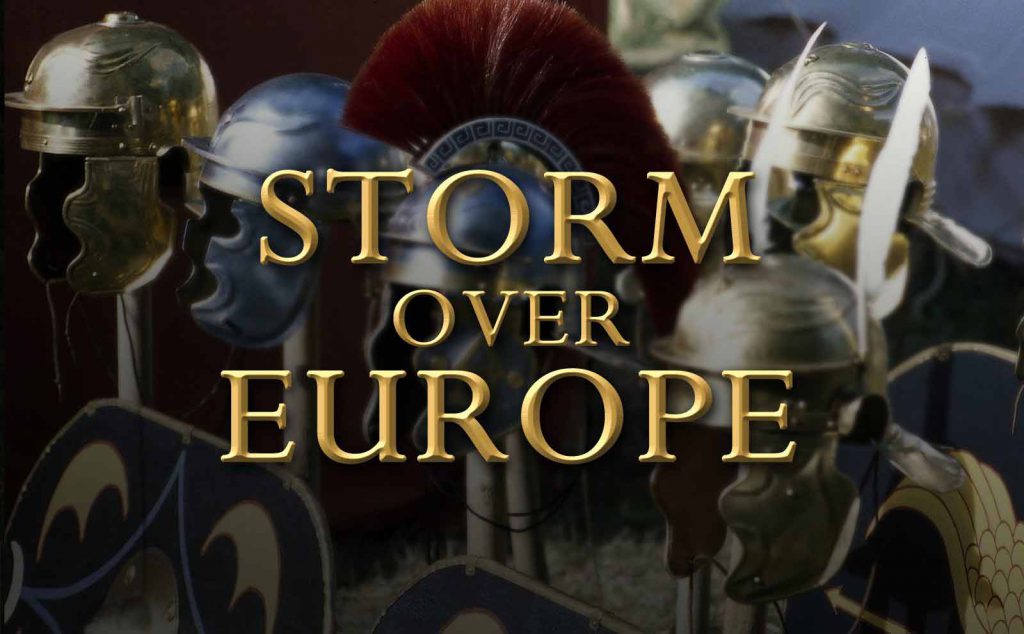Storm Over Europe episode 2 – The Saga of the Goths: The Romans knew virtually nothing about Germanic tribes, but this was to change. “They found skulls nailed to trees and altars. Here the Cherusci had sacrificed the most high-ranking Roman prisoners to their gods.” When Roman power was at its peak, in the year 9 AD, Arminius chief of the Cherusci defeated the troops of Rome at what was known for centuries as the Battle of Teutoburg Forest.
This documentary deals with the mass migration of Germanic tribes at the very beginning of European history, while Ancient Rome raced towards inevitable collapse and a new political centre developed in Northwest Europe. This period, from the invasion of the Huns in 375 to the conquest of Italy by the Lombards in 568, is one of the most fascinating, significant and complex epochs in history.
Storm Over Europe episode 2 – The Saga of the Goths
The Goths were a Germanic people who played a major role in the fall of the Western Roman Empire and the emergence of medieval Europe. In his book Getica (c. 551), the historian Jordanes writes that the Goths originated in southern Scandinavia, but the accuracy of this account is unclear. A people called the Gutones—possibly early Goths—are documented living near the lower Vistula River in the 1st century, where they are associated with the archaeological Wielbark culture.
From the 2nd century, the Wielbark culture expanded southwards towards the Black Sea in what has been associated with Gothic migration, and by the late 3rd century it contributed to the formation of the Chernyakhov culture. By the 4th century at the latest, several Gothic groups were distinguishable, among whom the Thervingi and Greuthungi were the most powerful. During this time, Ulfilas began the conversion of Goths to Arianism.
In the late 4th century, the lands of the Goths were invaded from the east by the Huns. In the aftermath of this event, several groups of Goths came under Hunnic domination, while others migrated further west or sought refuge inside the Roman Empire. Goths who entered the Empire by crossing the Danube inflicted a devastating defeat upon the Romans at the Battle of Adrianople in 378. These Goths would form the Visigoths, and under their king Alaric I they began a long migration, eventually establishing a Visigothic Kingdom in Spain at Toledo. Meanwhile, Goths under Hunnic rule gained their independence in the 5th century, most importantly the Ostrogoths. Under their king Theodoric the Great, these Goths established an Ostrogothic Kingdom in Italy at Ravenna.
The Ostrogothic Kingdom was destroyed by the Eastern Roman Empire in the 6th century, while the Visigothic Kingdom was conquered by the Umayyad Caliphate in the early 8th century. Remnants of Gothic communities in the Crimea, known as the Crimean Goths, lingered on for several centuries, although Goths would eventually cease to exist as a distinct people.
Battle of the Teutoburg Forest
The Battle of the Teutoburg Forest, described as the Varian Disaster (Clades Variana) by Roman historians, took place in the Teutoburg Forest in 9 CE, when an alliance of Germanic peoples ambushed Roman legions and their auxiliaries, led by Publius Quinctilius Varus. The alliance was led by Arminius, a Germanic officer of Varus’s auxilia. Arminius had acquired Roman citizenship and had received a Roman military education, which enabled him to deceive the Roman commander methodically and anticipate the Roman army’s tactical responses.
Teutoburg Forest is commonly seen as one of the most important defeats in Roman history, bringing the triumphant period of expansion under Augustus to an abrupt end. The outcome of this battle dissuaded the Romans from their ambition of conquering Germania, and is thus considered one of the most important events in European history.
The provinces of Germania Superior and Germania Inferior, sometimes collectively referred to as Roman Germania, were subsequently established in northeast Roman Gaul, while territories beyond the Rhine remained independent of Roman control. Retaliatory campaigns were commanded by Tiberius and Germanicus and would enjoy success, but the Rhine would eventually become the border between the Roman Empire and the rest of Germania. The Roman Empire would launch no other major incursion into Germania until Marcus Aurelius (r. 161–180) during the Marcomannic Wars.
Ironically, some of the descendants of the vassal kingdoms, like the Suebi, (by suzerainty) that Augustus tried to create in Germania to expand the romanitas and the Empire in a peaceful way, would be the ones that invaded the Empire in the 4th and 5th centuries.




